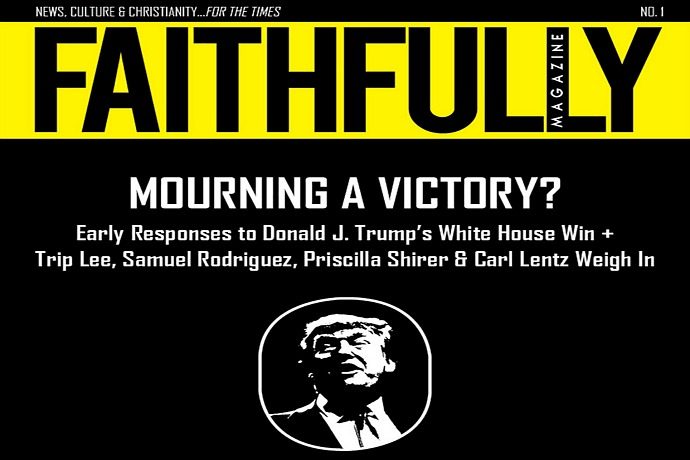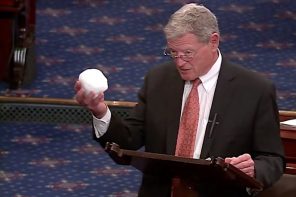For anyone who has spent any time on the religion beat, it doesn’t take long to realize it’s not exactly a rainbow coalition of culturally diverse reporters, or stories for that matter. The problem of inclusiveness that continues to bedevil the journalism field at large is sometimes amplified in religion writing, Christian media especially—with the journalists or the sources being largely male or white or both.
This disparity pushed religion reporter Nicola Menzie to launch Faithfully Magazine, a publication that centers the perspectives of writers and subjects of color. It started as a web magazine but has just expanded into print, with its inaugural print issue coming out this month.
I spoke with Menzie about the magazine’s first print issue and the narrowness of voices in Christian journalism.
What was your motivation for launching Faithfully Magazine? What kind of coverage can your readers expect?
The impetus behind launching Faithfully Magazine was basically just to provide another option, another outlet, another platform for Christians of color whose stories weren’t getting as much attention as they should. I just wanted to add more diversity of viewpoints.
With so much of media going digital, what was the motivation behind launching a print version?
At the core of it, I’ve always wanted to launch a print publication. I’m one of those people who just loves the printed word and having a physical copy of the book or magazine. So the love for that was first and foremost.
Secondly, even though print has been suffering quite a setback for a few years now, there are some parts of the market—especially niche publishers—that are still thriving. There still is an audience and readership there.
I guess the third part is I was experimenting to see what would work in terms of formatting for Faithfully. A print magazine, something they can touch, gets people more excited because it’s easier to visualize than just a website. It’s something that’ll endure as opposed to the web where sometimes stories are ephemeral and can disappear.
You’ve had more than a decade of experience as a religion reporter and have bylines at these various religion outlets like Religion News Service and The Christian Post. What about your previous experiences made you recognize that there was a lack of perspectives from Christians of color?
I’ve always found myself working in newsrooms where there’s a lack of diversity in the areas where it really counts. Yes, it’s good to have writers and staff who are diverse. However, I think it’s just as important to have diversity among the decision-makers, the ones who can kill a story.
Diversity is always lacking whether it is in Christian media or secular press. Once I got into the New York City office of The Christian Post, there was diversity in the newsroom, but the higher up you went in the chain, the less of it you saw.
There’s always good intentions, but there were occasions where we’d pursue certain stories and the list of folks that would come up as possible interview subjects all looked alike. I once was doing a series on young, up-and-coming pastors, and though I wasn’t able to participate in the editorial meeting, someone followed up with the list [of interviewees]. They were all white, and I found that strange. I brought it up, and we were able to add a bit more diversity to the list, but just little things like that.
A lot of outlets focus on celebrity Christianity, and that seems to be what drives a lot of the coverage. So in the beginning, I fell into pursuing the stories that people seemed to respond to the most. A lot of times, it ended up being about the same people or the same kind of people. Joel Osteen, Rick Warren, Rob Bell, Mark Driscoll, John Piper, on and on and on. I got to a point where I was able to step back and say, “Hold on a minute. This is not all that Christianity looks like.”
I decided I needed to pursue diversity in my coverage. I began to think more seriously or a lot deeper about the choices I was making in terms of reporting and the people I looked to for input on a story.
In your letter from the editor in the inaugural print issue, you mentioned how churches pay lip service to racial conciliation, but “white privilege is never nailed to the cross.” What do you think causes this disconnect between what leaders say and what actually ends up happening in churches?
There is disconnect because there is a lack of empathy, lack of deeper understanding, a lack of walking in the other person’s shoes and taking on their perspective. We need to move beyond them just saying, “Oh, racism is bad.”
What do we do after that? Do we understand how racism can rear its head in certain areas? Do we understand what we are seeing when we see a racial disparity in certain situations or organizations? How we can be co-laborers in bearing some of these burdens?
Do you feel the lack of diversity in religion reporting is just a reflection of the lack of diversity in newsrooms at large, or do you feel that the problem is particularly acute with religion outlets?
I feel like it’s a general problem in newsrooms. However, there probably are a few instances where it feels more specific to religion reporting. Let’s say I go to a convention for the Online News Association or the Society of Professional Journalists. If I go to the annual conference for one of these organizations I’m more likely to see more diversity there than I would at—and I’m not trying to throw them under the bus, I love this organization—the Religion News Association.
When I go to the conferences, I’m always looking around, and there just aren’t a lot of people of color there. Out of the 200 that were probably there, I could have counted the number of reporters of color on one or two hands. That says something to me. I don’t think it’s anything intentional, but there’s something missing there.
Of course, we always come back to the question, “Well, are there people of color pursuing journalism as a profession? Are they pursuing religion reporting as a profession?” That’s a fair question to ask as well. Institutions, schools, and organizations need to do a bit more collectively to bring more diversity to this sector.
My final question is how do you feel mainstream religion media has treated the coverage of white evangelicals post-election?
To speak bluntly, I don’t really care.
We’ve examined white evangelicals for so long—trying to find out how they feel, what they care about, and what they’re doing. That’s important because obviously a huge percentage of that faith group was responsible for Donald Trump being elected.
I get that, but let’s do some reflection and look at other groups. There are black Republicans who were Christians who voted for Donald Trump. What are they doing right now? I can tell you for a fact that black Republicans have been thirsty for a seat at the table for a long time now. Historically, black conservatives have been marginalized.
It’s not the case across the board, but from what I’ve been observing they want a place at the table, and I think they need a place at the table. We have that example when, at one of Donald Trump’s press conferences, a black journalist asked if he planned to hold a meeting with the Congressional Black Caucus. He responds with, “Are they friends of yours. Set up a meeting.”
There are so many other segments of the voting bloc that we can look at. We’ve looked at white evangelicals, poor or working-class whites, we get it. What about the poor or working-class blacks who also believed in the things Trump said? How about the Latinos who voted for Trump as well? It’s time to look at some of these other areas now.
The first print issue of Faithfully Magazine can be purchased here.





